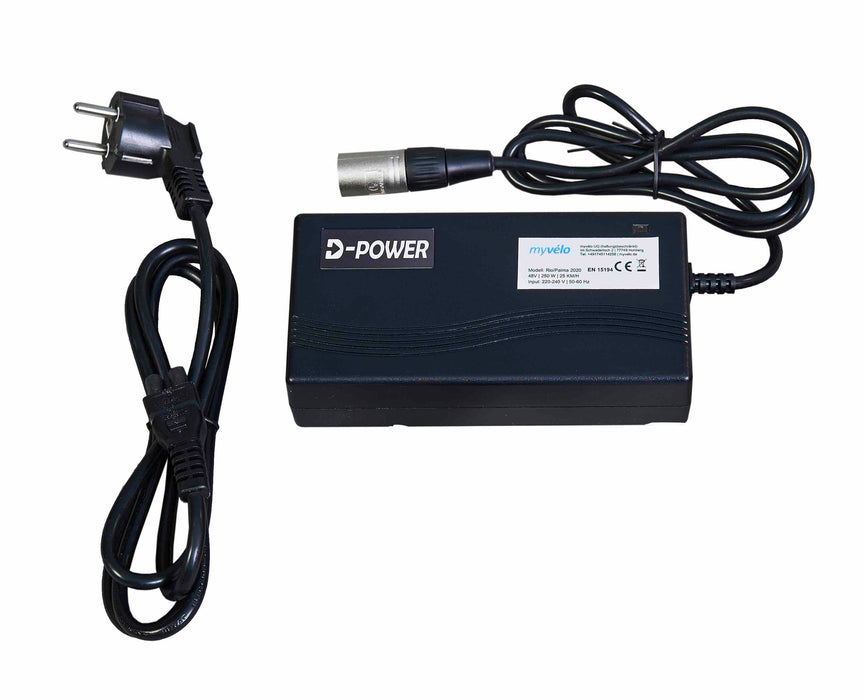
Charger for model Rio/Palma
incl. FREE shipping & free returns

Von Vincent Augustin |
5 minutes read time

Proper care and use can significantly extend the life of your battery and help you get the most out of each charge. In this article, you'll learn how to optimize your charging cycles and effectively maximize battery life.
A charge cycle describes the process of charging the battery from 0% to 100%. However, this does not mean that the battery must be fully discharged and charged each time to count as a charge cycle. Charge cycles are made up of several partial charges. For example, charging from 50% to 100% twice is equal to a full charge cycle.

The number of charging cycles that a battery can "survive" is limited. After a certain number, the battery's capacity begins to decrease. This means that after a certain time, your e-bike battery can no longer offer the full range. It is therefore important to use charging cycles as efficiently as possible.
Typically, lithium-ion batteries can go through about 500 to 1,000 full charge cycles before capacity begins to decrease noticeably. This means that after 500 to 1,000 cycles, the battery will no longer provide full range, but may only have 70-80% of its original capacity.
However, the charging cycles can be extended with good care and careful use. If you regularly only partially charge the battery (for example from 30% to 80%) and avoid deep discharges, you can increase the effective lifespan of the battery. In practice, a well-maintained battery can often last several years before it needs to be replaced.
Many e-bike users believe that they should fully discharge the battery before recharging it. This may have been the case with older battery types such as nickel-cadmium batteries, but it is not true for modern lithium-ion batteries used in most e-bikes. These batteries prefer regular partial charging.
To maximize the lifespan of your battery, you should discharge the battery to 0% as rarely as possible. Deep discharges put a strain on the battery and can reduce the number of charging cycles. It is ideal to charge the battery when it still has about 20-30% charge remaining. This ensures a more even charging cycle and protects the battery cells.

Another tip to extend battery life is not to always charge the battery to 100%. Although it is tempting to want to use the full capacity, a full charge puts more strain on the battery cells. Instead, in many cases it is sufficient to only charge the battery to around 80-90%, especially if you use your e-bike daily or regularly.
This practice is particularly useful if you know that you will not be travelling particularly long distances. The battery will last longer and the cells will remain in a healthier condition. For longer trips where you need the full range, it is of course sensible to charge the battery to 100%.
Temperatures have a big impact on battery life and performance. Both extreme heat and cold can affect battery efficiency and capacity.
High temperatures : If your battery is exposed to high temperatures for a long time (over 30°C), the cells can age more quickly. Make sure that you do not leave the battery in direct sunlight, especially while charging. Also do not charge the battery in the immediate vicinity of heat sources.
Low temperatures : In cold temperatures (below 10 °C) the performance of the battery can drop. You will notice this when driving as the range is reduced. When it is cold, ideally store the battery indoors and charge it in a room at room temperature.
Temperatures between 10 and 25 °C are ideal for storage and charging. This keeps the battery in a stable condition and you can use it for longer.
After a long ride, your e-bike battery may be warm. It is important to let the battery cool down before charging, as charging a hot battery puts additional stress on the cells. Therefore, give the battery about 30 minutes to cool down to room temperature before connecting it to the charger.
It can be tempting to buy a cheaper charger, especially if the original charger is lost or damaged. But this can be harmful to your battery in the long run. Manufacturers optimize their chargers for the specific battery capacity and chemistry. An inappropriate charger can overcharge, undercharge, or charge the battery unevenly, which will shorten its lifespan.
Therefore, use the charger that is suitable for the battery or a replacement charger recommended by the manufacturer. This ensures gentle and safe charging.
Sometimes your e-bike sits unused for a long time, be it in winter or because you simply ride it less. Even during this time, you should pay attention to the battery to protect its lifespan.
Do not fully charge the battery before storing it for a long time. A charge level between 40% and 60% is optimal. This keeps the cells in optimal condition and prevents them from becoming deeply discharged during storage. Also store the battery in a cool, dry place. Check the charge level every few months and recharge it if the capacity falls below 30%.
Even if it is sometimes not possible, you should use your e-bike battery regularly. Batteries that remain unused for a long period of time lose capacity. Even short trips and regular charging can help keep the cells "active".
However, avoid using the battery for short distances every day and charge it fully each time. Ideally, use your e-bike in such a way that you charge the battery a few times a week and do not constantly carry out small partial charges. This way you can find a healthy balance between use and protection.
Caring for the battery is crucial to getting the most out of your e-bike. With a few simple tips, you can optimize the charging cycles and extend the battery life. Remember to charge the battery regularly and carefully, avoid extreme temperatures and use the original charger. Correct storage and use are also crucial factors in ensuring you can enjoy your e-bike for a long time.
If you follow these tips, you will not only maximize your battery life, but also increase the efficiency of your e-bike - and that means more range and less worry about the next charging station!